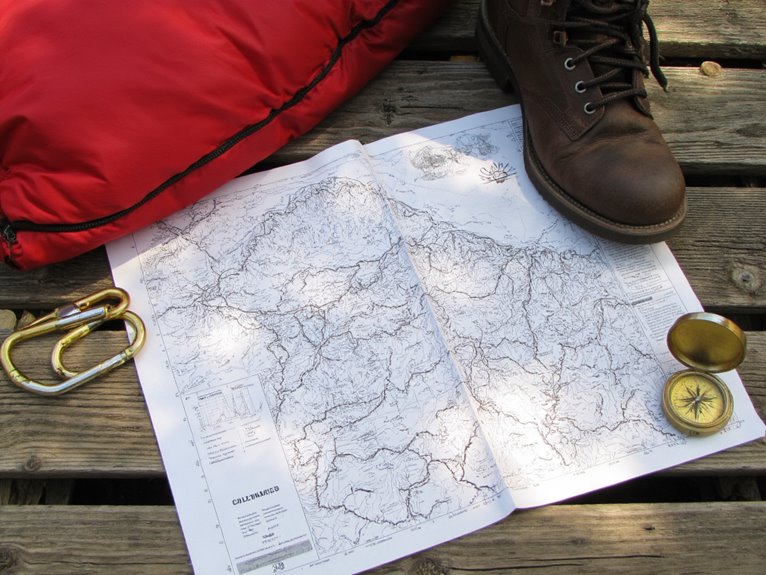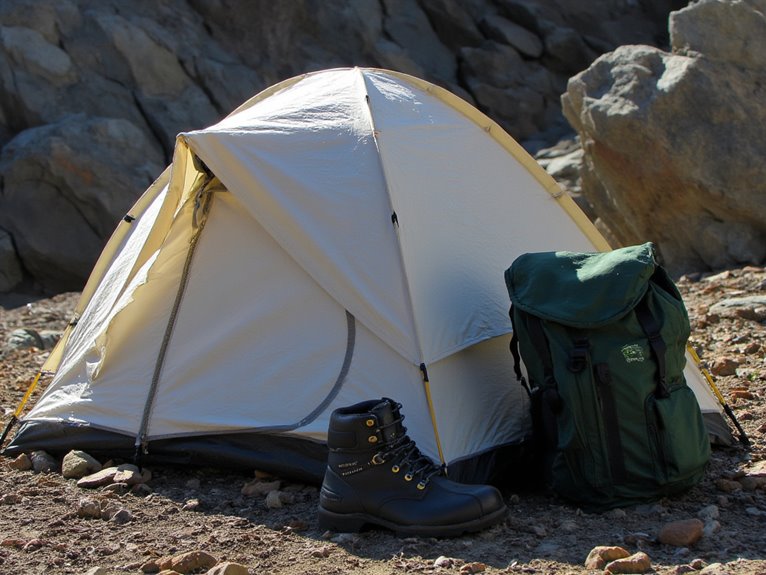How to Choose a Backpack Stove?
When choosing a backpack stove, consider key factors to guarantee a reliable and efficient cooking experience. Fuel type, boil time, and power output impact performance, while durability and weight affect portability. Wind and weather resistance, as well as maintenance and repair, are vital for longevity. Accessories and integration augment functionality, and budget considerations balance needs with spending. By evaluating these factors, you can select a stove that meets your outdoor cooking needs. To optimize your selection, it's essential to weigh these considerations carefully and consider the specifics of your wilderness adventures.
We are supported by our audience. When you purchase through links on our site, we may earn an affiliate commission, at no extra cost for you. Learn more. Last update on 19th December 2025 / Images from Amazon Product Advertising API.
Fuel Types: Weighing the Options
When venturing into the wilderness, the type of fuel used in a backpack stove can greatly impact the overall hiking experience, making it vital to weigh the options carefully.
There are three primary fuel types to examine: white gas, canister fuel, and liquid fuel.
White gas, also known as naphtha, is a popular choice due to its high energy density and cold-weather performance.
Canister fuel, comprising a mix of propane and isobutane, offers convenience and ease of use.
Liquid fuel, such as diesel or kerosene, provides a reliable option for international travel.
Each fuel type has its advantages and drawbacks, and understanding these differences is essential for selecting the right stove for your backpacking needs.
Boil Time: Speed Matters
When evaluating backpack stoves, boil time is a critical factor to weigh.
A quick boil time not only saves time and energy but also amplifies the overall camping experience.
In this section, we'll examine the importance of boil time, fuel efficiency, and performance in windy conditions to help you make an informed decision in selecting a backpack stove.
Quick Boil Times Matter
A backpack stove's ability to quickly boil water is vital in the backcountry, as it directly impacts the speed at which you can rehydrate, eat, and get moving again. When every minute counts, a stove that can rapidly boil water is essential.
Faster rehydration is a key benefit of a quick-boil stove. Quickly boiled water means you can rehydrate faster, reducing the risk of dehydration and fatigue.
Rapid boiling times also enable efficient meal prep. You can prepare meals quickly, getting you back on the trail sooner.
With a quick-boil stove, you can allocate more time to other essential tasks, such as setting up camp or navigating challenging terrain, increasing productivity.
Fuel Efficiency Counts
Optimizing fuel efficiency is essential in the backcountry, as it directly correlates with the duration of your stove's operational life and the weight of your pack.
A fuel-efficient stove means less fuel consumption, which translates to a lighter pack and extended stove usage.
When evaluating stoves, look for models with high fuel efficiency ratings, typically measured in minutes per ounce of fuel.
A more efficient stove will boil water faster while conserving fuel, allowing you to enjoy a hot meal without worrying about running out of fuel.
Consider stoves with features like precision flame control, which enables you to adjust the flame to optimize fuel consumption.
Speed in Windy Conditions
In addition to fuel efficiency, a stove's ability to quickly boil water in windy conditions is vital for backcountry cooking, as it can mean the difference between a hot meal and a cold, energy-sapping wait.
When evaluating a backpack stove's performance in windy conditions, consider the following key factors:
Windscreen design: A well-designed windscreen can notably improve boil times in windy conditions.
Stove pot support: A sturdy pot support can help maintain a consistent flame, even in strong winds.
Burner design: A burner designed to maintain a consistent flame in windy conditions can make a substantial difference in boil times.
Power Output: Measuring Efficiency
When evaluating a backpack stove's power output, it's essential to ponder multiple metrics to get a thorough picture of its efficiency.
A stove's performance can be measured by its watts per ounce ratio, fuel efficiency rating, and boil time performance, which collectively provide a clear understanding of its ability to deliver heat quickly and sustainably.
Watts Per Ounce Ratio
A backpack stove's watts per ounce ratio, a critical metric for backcountry enthusiasts, provides a meaningful way to compare the power output of various stoves relative to their weight. This ratio helps you determine which stove is the most efficient, considering both power output and packability.
When evaluating stoves, look for the following key aspects:
A higher watts per ounce ratio indicates a more efficient stove, as it produces more power relative to its weight.
Consider your specific needs: do you prioritize a lightweight stove or a more powerful one?
Use the watts per ounce ratio to compare different stoves and make an informed decision based on your specific requirements.
Fuel Efficiency Rating
Beyond the watts per ounce ratio, another key factor in evaluating a backpack stove's performance is its fuel efficiency rating, which directly impacts the overall energy output and endurance of the stove.
A higher fuel efficiency rating indicates that the stove can produce more energy from a given amount of fuel, resulting in a longer burn time and reduced fuel consumption.
When evaluating fuel efficiency, look for stoves with high ratings, typically measured in grams of fuel consumed per minute.
A lower fuel consumption rate translates to longer trips between refueling and reduced environmental impact.
Opt for stoves with high fuel efficiency ratings to maximize your energy output while minimizing fuel waste.
Boil Time Performance
A backpack stove's boil time performance serves as a vital indicator of its overall power output, allowing users to gauge its ability to efficiently boil water and prepare meals.
This metric is particularly important for backpackers and outdoor enthusiasts who need to quickly prepare hot meals in the wilderness.
When evaluating boil time performance, consider the following key factors:
Boil time: Look for stoves that can boil water quickly, ideally within 3-5 minutes.
Power output: A higher power output (measured in watts) typically translates to faster boil times.
Wind resistance: A stove's ability to maintain its boil time performance in windy conditions is essential for outdoor use.
Durability: Withstanding the Elements
When venturing into the wilderness, a backpack stove's ability to withstand harsh environmental conditions is vital, as it directly impacts the reliability of meal preparation and overall outdoor experience.
A durable stove can withstand exposure to wind, rain, snow, and extreme temperatures.
Look for stoves with durable materials, such as stainless steel or titanium, and a waterproof design. A stove's construction and seals should be able to prevent moisture and debris from entering the system.
Additionally, consider stoves with protective cases or storage bags to shield the stove from the elements when not in use.
A durable stove guarantees that you can rely on it to perform consistently, even in the most challenging outdoor conditions.
Weight and Compactness: Hiking Friendly
When choosing a backpack stove, it's essential to weigh the delicate balance between weight, compactness, and performance.
Three key factors to prioritize:
Foldable or collapsible design: Look for stoves that can be easily stowed away in a compact form, making them easy to carry on long hikes.
Lightweight materials: Opt for stoves made from lightweight yet durable materials, such as aluminum or titanium, to minimize weight without compromising performance.
Modular components: Choose stoves with modular components that can be easily detached and stowed, reducing overall bulk and making them easier to transport.
Ignition Systems: Easy Startups
In the realm of backpack stoves, a reliable ignition system is vital for easy startups.
There are two primary methods of spark generation: electronic ignition, which uses a battery-powered spark, and flint-based ignition, which generates a spark through manual operation.
Understanding the advantages and limitations of each method is essential for selecting the right stove for your backpacking needs.
Spark Generation Methods
Spark generation methods, a critical component of backpack stove ignition systems, rely on one of three primary techniques to produce a reliable spark: flint and steel, piezoelectric, or electronic ignition. Each method has its advantages and disadvantages, and the right choice depends on personal preference, climate, and usage.
- Flint and Steel: Simple, reliable, and low-maintenance, but may require more effort to generate a spark.
- Piezoelectric: Fast and easy to use, but may be more prone to mechanical failure.
- Electronic Ignition: Convenient and quick, but often requires batteries and may be less reliable in wet conditions.
When choosing a backpack stove, consider the spark generation method that best suits your needs and preferences.
Reliable Flame Sources
Reliable flame sources are a critical aspect of backpack stove design, as they facilitate easy startups and consistent performance in various outdoor conditions.
A reliable flame source guarantees that your stove ignites quickly and maintains a steady flame, even in windy or damp conditions.
Look for stoves with Piezo ignition systems, which generate a high-voltage spark to ignite the fuel. Some stoves also feature a battery-powered ignition system, which provides a consistent spark.
Other features to examine include automatic ignition, which eliminates the need for a separate igniter, and manual ignition, which provides a backup option in case of electronic failure.
A reliable flame source is vital for a hassle-free outdoor cooking experience.
Wind and Weather Resistance
A backpack stove's ability to perform well in windy and inclement weather conditions is essential for a successful outdoor adventure.
When choosing a backpack stove, consider its wind and weather resistance to guarantee reliable performance in harsh conditions.
Look for stoves with features that mitigate wind and weather effects, such as:
Windshields: Protect the flame from gusts and reduce heat loss.
Weather-resistant materials: Durable materials that withstand rain, snow, and extreme temperatures.
Adjustable flames: Allow for adjustments to compensate for wind and weather conditions.
Maintenance and Repair
Proper maintenance and repair of a backpack stove are vital to guarantee peak performance and extend its lifespan.
Regular cleaning of the stove, fuel lines, and burner head is essential to prevent clogging and maintain efficient combustion.
Inspect the stove and fuel system for signs of wear and tear, and replace worn-out parts promptly.
Store the stove in a dry place, away from direct sunlight, to prevent corrosion.
Perform routine checks on the O-ring and gaskets, replacing them as needed.
Accessories and Integration
Integrate your backpack stove with a range of accessories to augment its functionality and customize your outdoor cooking experience.
By incorporating the right add-ons, you can boost performance, convenience, and safety.
Consider the following essential accessories to integrate with your backpack stove:
A Windscreen shields the flame from gusts, ensuring stable combustion and efficient fuel consumption.
A Pot support provides a stable platform for your cookware, allowing for effortless meal preparation.
A Carrying case protects your stove and accessories during transportation, keeping them organized and within reach.
Budget and Value Considerations
When selecting a backpack stove, it's essential to balance performance and features with budget constraints, as the cost of a stove can vary greatly depending on the brand, quality, and features.
A budget-friendly option may sacrifice some performance or durability, while a high-end stove may offer advanced features but come with a hefty price tag.
Consider your needs and prioritize your spending accordingly. If you're a casual backpacker, a entry-level stove may suffice, whereas frequent or long-distance trekkers may require a more advanced stove.
Weigh the cost against the benefits and consider the overall value proposition to make an informed decision that meets your needs and budget.





